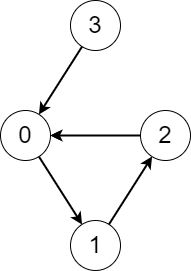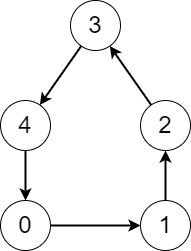


题目描述
现有一个有向图,其中包含 n 个节点,节点编号从 0 到 n - 1 。此外,该图还包含了 n 条有向边。
给你一个下标从 0 开始的数组 edges ,其中 edges[i] 表示存在一条从节点 i 到节点 edges[i] 的边。
想象在图上发生以下过程:
- 你从节点
x 开始,通过边访问其他节点,直到你在 此过程 中再次访问到之前已经访问过的节点。
返回数组 answer 作为答案,其中 answer[i] 表示如果从节点 i 开始执行该过程,你可以访问到的不同节点数。
示例 1:

输入:edges = [1,2,0,0]
输出:[3,3,3,4]
解释:从每个节点开始执行该过程,记录如下:
- 从节点 0 开始,访问节点 0 -> 1 -> 2 -> 0 。访问的不同节点数是 3 。
- 从节点 1 开始,访问节点 1 -> 2 -> 0 -> 1 。访问的不同节点数是 3 。
- 从节点 2 开始,访问节点 2 -> 0 -> 1 -> 2 。访问的不同节点数是 3 。
- 从节点 3 开始,访问节点 3 -> 0 -> 1 -> 2 -> 0 。访问的不同节点数是 4 。
示例 2:

输入:edges = [1,2,3,4,0]
输出:[5,5,5,5,5]
解释:无论从哪个节点开始,在这个过程中,都可以访问到图中的每一个节点。
提示:
n == edges.length2 <= n <= 1050 <= edges[i] <= n - 1edges[i] != i
解法
方法一:基环树 + 遍历搜索
我们可以用一个数组 \(ans\) 记录每个节点的答案,用一个数组 \(vis\) 记录每个节点的访问次序。
遍历每个节点 \(i\),如果当前节点 \(i\) 未被访问,我们就从节点 \(i\) 开始遍历,此时有两种情况:
- 如果遍历过程中,遇到了当前节点出发时走过的节点,那么此次遍历,一定是先走到了环内,然后沿着环走了一圈。对于环外的节点,其答案就是环的长度加上节点到环的距离;对于环内的节点,其答案就是环的长度。
- 如果遍历过程中,遇到了此前节点出发时走过的节点,那么对于每个走过的节点,其答案就是当前节点到此节点的距离,加上此节点的答案。
时间复杂度 \(O(n)\),空间复杂度 \(O(n)\)。其中 \(n\) 是数组 \(edges\) 的长度。
1
2
3
4
5
6
7
8
9
10
11
12
13
14
15
16
17
18
19
20
21
22 | class Solution:
def countVisitedNodes(self, edges: List[int]) -> List[int]:
n = len(edges)
ans = [0] * n
vis = [0] * n
for i in range(n):
if not ans[i]:
cnt, j = 0, i
while not vis[j]:
cnt += 1
vis[j] = cnt
j = edges[j]
cycle, total = 0, cnt + ans[j]
if not ans[j]:
cycle = cnt - vis[j] + 1
total = cnt
j = i
while not ans[j]:
ans[j] = max(total, cycle)
total -= 1
j = edges[j]
return ans
|
1
2
3
4
5
6
7
8
9
10
11
12
13
14
15
16
17
18
19
20
21
22
23
24
25
26 | class Solution {
public int[] countVisitedNodes(List<Integer> edges) {
int n = edges.size();
int[] ans = new int[n];
int[] vis = new int[n];
for (int i = 0; i < n; ++i) {
if (ans[i] == 0) {
int cnt = 0, j = i;
while (vis[j] == 0) {
vis[j] = ++cnt;
j = edges.get(j);
}
int cycle = 0, total = cnt + ans[j];
if (ans[j] == 0) {
cycle = cnt - vis[j] + 1;
}
j = i;
while (ans[j] == 0) {
ans[j] = Math.max(total--, cycle);
j = edges.get(j);
}
}
}
return ans;
}
}
|
1
2
3
4
5
6
7
8
9
10
11
12
13
14
15
16
17
18
19
20
21
22
23
24
25
26 | class Solution {
public:
vector<int> countVisitedNodes(vector<int>& edges) {
int n = edges.size();
vector<int> ans(n), vis(n);
for (int i = 0; i < n; ++i) {
if (!ans[i]) {
int cnt = 0, j = i;
while (vis[j] == 0) {
vis[j] = ++cnt;
j = edges[j];
}
int cycle = 0, total = cnt + ans[j];
if (ans[j] == 0) {
cycle = cnt - vis[j] + 1;
}
j = i;
while (ans[j] == 0) {
ans[j] = max(total--, cycle);
j = edges[j];
}
}
}
return ans;
}
};
|
1
2
3
4
5
6
7
8
9
10
11
12
13
14
15
16
17
18
19
20
21
22
23
24
25
26 | func countVisitedNodes(edges []int) []int {
n := len(edges)
ans := make([]int, n)
vis := make([]int, n)
for i := range ans {
if ans[i] == 0 {
cnt, j := 0, i
for vis[j] == 0 {
cnt++
vis[j] = cnt
j = edges[j]
}
cycle, total := 0, cnt+ans[j]
if ans[j] == 0 {
cycle = cnt - vis[j] + 1
}
j = i
for ans[j] == 0 {
ans[j] = max(total, cycle)
total--
j = edges[j]
}
}
}
return ans
}
|
1
2
3
4
5
6
7
8
9
10
11
12
13
14
15
16
17
18
19
20
21
22
23
24 | function countVisitedNodes(edges: number[]): number[] {
const n = edges.length;
const ans: number[] = Array(n).fill(0);
const vis: number[] = Array(n).fill(0);
for (let i = 0; i < n; ++i) {
if (ans[i] === 0) {
let [cnt, j] = [0, i];
while (vis[j] === 0) {
vis[j] = ++cnt;
j = edges[j];
}
let [cycle, total] = [0, cnt + ans[j]];
if (ans[j] === 0) {
cycle = cnt - vis[j] + 1;
}
j = i;
while (ans[j] === 0) {
ans[j] = Math.max(total--, cycle);
j = edges[j];
}
}
}
return ans;
}
|




